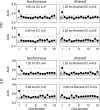Temporal weighting functions for interaural time and level differences. II. The effect of binaurally synchronous temporal jitter
- PMID: 21303010
- PMCID: PMC3055287
- DOI: 10.1121/1.3514422
Temporal weighting functions for interaural time and level differences. II. The effect of binaurally synchronous temporal jitter
Abstract
Recent work has demonstrated that sensitivity to interaural time differences (ITD) carried by high-rate cochlear implant pulse trains or analogous acoustic signals can be enhanced by imposing random temporal variation on the stimulus rate [see Goupell et al. (2009). J. Acoust. Soc. Am. 126, 2511-2521]. The present study characterized the effect of such "temporal jitter" on normal-hearing listeners' weighting of ITD and interaural level differences (ILD) applied to brief trains of Gabor clicks (4 kHz center frequency) presented at nominal interclick intervals (ICI) of 1.25 and 2.5 ms. Lateral discrimination judgments were evaluated on the basis of the ITD or ILD carried by individual clicks in each train. Random perturbation of the ICI significantly reduced listeners' weighting of onset cues for both ITD and ILD discrimination compared to corresponding isochronous conditions, consistent with enhanced sensitivity to post-onset binaural cues in jittered stimuli, although the reduction of onset weighting was not statistically significant at 1.25 ms ICI. An additional analysis suggested greater weighting of ITD or ILD presented following lengthened versus shortened ICI, although weights for such "gaps" and "squeezes" were comparable to other post-onset weights. Results are discussed in terms of binaural information available in jittered versus isochronous stimuli.
Figures




Similar articles
-
Temporal weighting functions for interaural time and level differences. III. Temporal weighting for lateral position judgments.J Acoust Soc Am. 2013 Aug;134(2):1242-52. doi: 10.1121/1.4812857. J Acoust Soc Am. 2013. PMID: 23927122 Free PMC article.
-
Temporal weighting of binaural cues revealed by detection of dynamic interaural differences in high-rate Gabor click trains.J Acoust Soc Am. 2010 May;127(5):3092-103. doi: 10.1121/1.3377088. J Acoust Soc Am. 2010. PMID: 21117758 Free PMC article.
-
Temporal weighting of interaural time and level differences in high-rate click trains.J Acoust Soc Am. 2010 Jul;128(1):332-41. doi: 10.1121/1.3436540. J Acoust Soc Am. 2010. PMID: 20649228 Free PMC article.
-
Temporal weighting functions for interaural time and level differences. IV. Effects of carrier frequency.J Acoust Soc Am. 2014 Dec;136(6):3221. doi: 10.1121/1.4900827. J Acoust Soc Am. 2014. PMID: 25480069 Free PMC article.
-
Perception and coding of interaural time differences with bilateral cochlear implants.Hear Res. 2015 Apr;322:138-50. doi: 10.1016/j.heares.2014.10.004. Epub 2014 Oct 19. Hear Res. 2015. PMID: 25456088 Review.
Cited by
-
Temporal weighting functions for interaural time and level differences. V. Modulated noise carriers.J Acoust Soc Am. 2018 Feb;143(2):686. doi: 10.1121/1.5022785. J Acoust Soc Am. 2018. PMID: 29495689 Free PMC article.
-
Threshold of the precedence effect in noise.J Acoust Soc Am. 2014 May;135(5):2923-30. doi: 10.1121/1.4869682. J Acoust Soc Am. 2014. PMID: 24815272 Free PMC article.
-
Strength of onset and ongoing cues in judgments of lateral position.J Acoust Soc Am. 2017 Jul;142(1):206. doi: 10.1121/1.4990020. J Acoust Soc Am. 2017. PMID: 28764482 Free PMC article.
-
The effect of envelope modulations on binaural processing.Hear Res. 2019 Aug;379:117-127. doi: 10.1016/j.heares.2019.05.003. Epub 2019 May 21. Hear Res. 2019. PMID: 31154164 Free PMC article.
-
High-resolution temporal weighting of interaural time differences in speech.J Acoust Soc Am. 2021 Aug;150(2):1311. doi: 10.1121/10.0005934. J Acoust Soc Am. 2021. PMID: 34470281 Free PMC article.
References
-
- Berg, B. G. (1989). “Analysis of weights in multiple observation tasks,” J. Acoust. Soc. Am. 98, 1909–1920. - PubMed
-
- Dizon, R. M., Culling, J. F., Litovsky, R. L., Shinn-Cunningham, B. G., and Colburn, H. S. (1998). “On the development of a post-onset temporal weighting function,” Assoc. Res. Otolaryngol. Abstr. 21, 42.
Publication types
MeSH terms
Grants and funding
LinkOut - more resources
Full Text Sources

